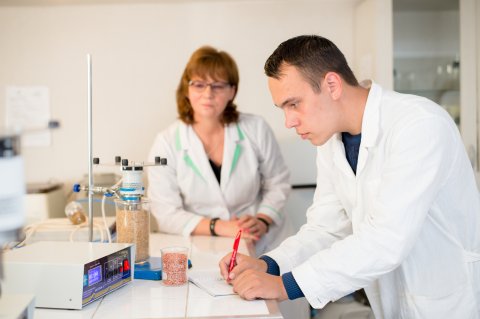The Synthesis and Analysis of Food Ingredients Laboratory was opened at the SUSU School of Medical Biology in 2016 within Project 5-100. The laboratory’s activities aim at searching for solutions of the tasks in the field of developing the technologies of synthesis of food biopolymers and using them as a basis to create modified forms through exposure to ultrasound. The laboratory is headed by Professor of National Institute of Technology, Warangal, India, Shirish Sonowane, and on behalf of SUSU the laboratory is supervised by Doctor of Sciences (Engineering), Professor Irina Potoroko.
Master’s students of a project-based learning group studying in 19.04.01 Biotechnology programme of the Department of Food and Biotechnology of the School of Medical Biology Artem Malinin and Aram Tsaturov answer our questions.
– Quite recently your laboratory has shared on a project of biodegradable polymers, and today you are already talking about edible plastic.
Indeed, we’re trying to find as many practical variants of applying our developments as possible. Today we’ve launched a second field of studying biopolymers, which formed at the stage of assessing the properties of new materials.
We started the project from the modification of the traditional recipe of bioplastic through its exposure to ultrasound. This is a mixture of potato starch, plasticizer and solvent, exposed to ultrasonic cavitation, what changes its structure. The material, which we obtain as a result, we call a biodegradable polymer.
To obtain the biopolymer, in our research we use potato starch, which has an optimum ratio of amylose and amylopectin in its composition. Foreign sources widely use corn starch, but for our region it is more rational to use namely potato since it is an accessible and cheap raw material. As our studies show, the biofilms obtained through ultrasound exposure, turn out to be more transparent, elastic and are a good alternative for polyethylene bags. Currently, we’re developing an optimal ratio of the components and the time of exposure to ultrasonic cavitation.
The second field is the obtaining of a pectin-based biodegradable polymer by finding a certain ratio of components and mixing them. Meanwhile, it is important to note that pectins are extracted from wastes at the stage of starch producing. We believe that this a possibility of implementing resources-saving technologies and a good proposal for the processors of vegetable raw materials.
In this research, we’re suing such film-forming substances as pectin and additional bioactive substances, in particular – curcumin, which we encapsulate using ultrasound. Curcumin has anti-oxidant action, what will allow us to increase the product shelf life, if such films are used a packaging materials. Pectin-made biopolymers, unlike the polymers obtained using the first method, are thicker and have little transparency.
– So, how products packaged in it could be stored?
Each product should have a polymer film developed for it, with certain properties. Currently, we’re engineering a technology of creating containers made of edible degradable biopolymer for storing liquid products.
– Who is participating in this project?
A proactive scientific team has been formed at the laboratory comprising postgraduates, Master’s students and young scientists, who are interested in developing the technologies of producing biocomposites using microingredients of vegetable raw materials. Today, our international team includes researchers from Institute of Technology, Warangal, India; and Medical University of Varna, Bulgaria.
We are open for joint work, and are attracting investments from small and medium business. By the present moment our main strategic partner on promoting the developed technologies and offering them to real customers is the Crop Production Department of the Ministry of Agriculture for the Chelyabinsk Region. Agricultural and processing enterprises, such as OOO Borovoe, are also interested in the technologies that we’re developing.
– Are there world practices of developing biodegradable polymers?
The technology itself is not new as the environmental problem is a concern for many people today. Foreign countries already have such practices of producing environment-friendly biodegradable polymers; however, there is no enough publicly available information about it yet. Currently, our task is to develop our own unique product, which will have the same physical characteristics as common polyethylene or plastic, but which will be safe for the environment.
– What does the process of biopolymer degradation include?
We have conducted research with the samples produced from grain and potato starches exposed to ultrasonic cavitation by placing them in an aggressive medium containing spores of aerobic mold fungi (Aspergillus genus). The results confirmed that our films are biodegradable!
We also placed the films into hot and cold water, where they dissolved with time. Today, our task is to slow down this process since there exist certain food components, which could slow down the process of dissolving, and thus we could broaden the range of application of the biopolymers.
– Can these biopolymers be recycled?
It’s an important question for us, too, and we keep asking it ourselves. Probably, we could answer it after we perform a complex research in the nearest future.
– Could you please share on your future plans on studying biodegradable polymers?
We consider the obtaining of stable biodegradable polymers, including the edible ones, as our main field. And in the future we will be working on shaping these biopolymers and using them to produce full-value tableware, which could resist temperature drop and destruction in a liquid medium for a certain period of time.
And of course, we’d like to consider the possibility of using different types of starch keeping in mind the resource base of our region and surplus of vegetable raw materials, in particular of potato and grains.




